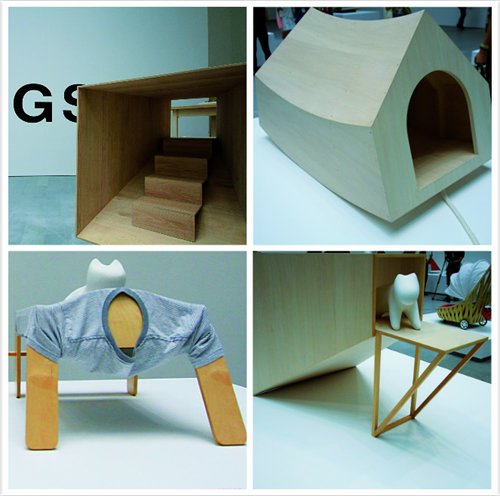Architecture for dogs
International designers make innovative canine abodes in this new exhibition
Dogs are man's best friend. Many dogs live with their owners under the same roof, in a structure made by humans that caters to human taste.
It never occurs to us whether or not dogs are comfortable climbing human stairs, when each step is 15 cm high, or jumping onto smooth desks and chairs - which may hurt their paws - or even holding their heads up all the time to meet the eyes of their masters.
Challenged by these questions, famous Japanese designer and MUJI art director Kenya Hara decided to give dogs a space of their own by updating the classic doghouse design.
Curated by Kenya Hara, Architecture for Dogs features 14 sets of specially designed doghouses by famous architects and designers.
Launched in 2012, the widely acclaimed exhibition has just made its sixth stop at Shanghai Himalayas Museum and will run through October 11.

Architecture for Dogs features 14 sets of specially designed doghouses by famous architects and designers. Photos: Qi Xijia/GT
Doghouse metamorphosis
When one thinks of a doghouse, what first comes to mind is a miniature version of a human shelter with a roof, door and windows. A typical example is Snoopy's red wooden house.
In this exhibition, the architects break the doghouse stereotype by working with different materials and forms. They transform the doghouse into an elegant and playful object, creating interactive joy for both dogs and humans.
MVRDV, a Rotterdam-based architecture and urban design practice, created a flexible structure for the beagle, catering to its playful and intelligent nature.
The doghouse has an arching bottom. Every time the dog enters the house, it responds with a subtle movement. A rope attached to the house makes it easy for masters to carry the doghouse anywhere.
White, soft and fluffy, the cotton candy-shaped doghouse designed by Kazuyo Sejima resembles the bichon frisé with its fascinating fur. When the dog sits comfortably in the house, it's hard to tell if it is a doghouse or a larger-sized dog.
The curator said that when they brought a bichon to this doghouse, it was too engrossed in examining the texture of the structure to leave it.
If the summer heat in Shanghai doesn't suit the fluffy, heavy coat of the bichon frisé, how about a doghouse with a cooling system?
Japanese architect Hiroshi Naito made a cooling house for his beloved dog, Pepe, a fluffy spitz who often lolled and panted in the unbearable summer heat.
The structure is made of several aluminum pipes. By inserting a plastic bag filled with ice into the aluminum pipe, one can quickly decrease the surface temperature.
To allow the dog to keep a firm footing on the pipes, the designer placed wooden slats between the metal tubes and connected the metal to the wood with a rubber hose.
What the dog saw
Architecture for Dogs is not merely a group exhibition for creative kennels but also offers new ways to approach the relationship between humans and dogs, allowing humans to look at the world from a dog's perspective.
In Hara's own work, D-Tunnel, we see the two worlds linked together through a tunnel. The inspiration for this structure comes from a gramophone.
"Going down the tunnel, it levels itself to the dog's world; going up the tunnel, it scales to the human level. In this image of space I added the steps. When a person is seated at a chair, he or she can make natural eye contact with the dog at the top of the staircase," said Hara in the curatorial statement.
Viewed pragmatically, D-Tunnel can also be seen as a piece of furniture with ladders attached. It can be placed in the house and used as a stool or a coffee table. The sharing of an object like this adds new depth to the interactions between dogs and their masters.
In the Shanghai stop on the tour, an enlarged version of D-Tunnel is exhibited. Visitors can walk into the space and observe the surroundings from a dog's point of view.
DIY doghouse
Some of the structures are made of very simple material. For example, the piece by the Hara Design Institute is made solely from a large sheet of thick paper. Cut the paper into a fan shape, fold it into a cone and hang it on the ceiling with a string. Without a single nail, you've created a house for your dog.
In a piece by Torafu Architects, a used T-shirt is made into a bed for Jack Russell terrier. The structure is created from a wooden frame on which the master's used clothes are stretched. Depending on the weight of the dogs and the different seasons, the clothes can be changed accordingly.
Anyone who wishes to build a doghouse on their own is welcome to download the unique architecture plans online and contribute their own construction ideas. A selection of architectural kits is also available online for purchase.
Other highlights of the exhibition include a structure from renowned Chinese architect Ma Yansong, which is newly added to this stop of Architecture for Dogs, and the Puppy Park, a space right outside the gallery in which dogs can experience the houses designed for them.
Date: Until October 11, 10 am to 6 pm
Venue: Shanghai Himalayas Museum
Address: 3/F, 869 Yinghua Road
樱花路869号3楼
Admission: 100 yuan ($16.11)
Call 5033-9801 for details